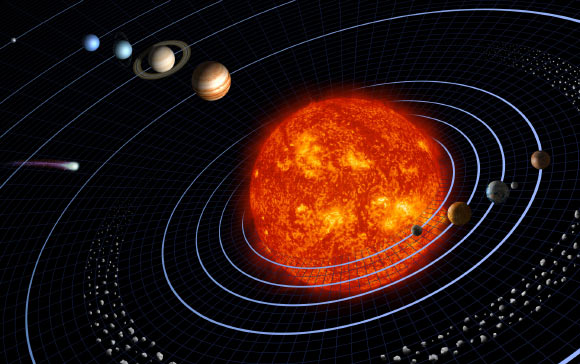To determine the motion of the Solar System, Bielefeld University astrophysicist Lukas Böhme and his colleagues analyzed the distribution of radio galaxies.

An artist’s impression of the Solar System. Image credit: NASA / JPL.
“Our analysis shows that the Solar System is moving more than three times faster than current models predict,” said Dr. Böhme, lead author of the study.
“This result clearly contradicts expectations based on standard cosmology and forces us to reconsider our previous assumptions.”
In their study, the authors analyzed the distribution of so-called radio galaxies — distant galaxies that emit particularly strong radio waves, a form of electromagnetic radiation with very long wavelengths similar to those used for radio signals.
Because radio waves can penetrate dust and gas that obscure visible light, radio telescopes can observe galaxies invisible to optical instruments.
As the Solar System moves through the Universe, this motion produces a subtle ‘headwind:’ slightly more radio galaxies appear in the direction of travel.
The difference is tiny and can only be detected with extremely sensitive measurements.
Using data from the LOFAR (Low Frequency Array) telescope and two additional radio observatories, the astronomers were able to make an especially precise count of such radio galaxies for the first time.
They applied a new statistical method that accounts for the fact that many radio galaxies consist of multiple components.
This improved analysis yielded larger but also more realistic measurement uncertainties.
Despite this, the combination of data from all three radio telescopes revealed a deviation exceeding five sigma, a statistically very strong signal considered in science as evidence for a significant result.
The measurement shows an anisotropy (dipole) in the distribution of radio galaxies that is 3.7 times stronger than what the Standard Model of the Universe predicts.
This model describes the origin and evolution of the cosmos since the Big Bang and assumes a largely uniform distribution of matter.
“If our Solar System is indeed moving this fast, we need to question fundamental assumptions about the large-scale structure of the Universe,” said Bielefeld University’s Professor Dominik Schwarz, co-author of the study.
“Alternatively, the distribution of radio galaxies itself may be less uniform than we have believed.”
“In either case, our current models are being put to the test.”
The new results confirm earlier observations in which astronomers studied quasars, the extremely bright centers of distant galaxies where supermassive black holes consume matter and emit enormous amounts of energy.
The same unusual effect appeared in these infrared data, suggesting that it is not a measurement error but a genuine feature of the Universe.
The study highlights how new observational methods can fundamentally reshape our understanding of the cosmos and how much there still remains to discover in the Universe.
The study was published this month in the journal Physical Review Letters.
_____
Lukas Böhme et al. 2025. Overdispersed Radio Source Counts and Excess Radio Dipole Detection. Phys. Rev. Lett 135, 201001; doi: 10.1103/6z32-3zf4



![The image shows NGC 1866 superimposed with a false color image from the MUSE data cube, where the ionized shell of the planetary nebula Ka LMC 1 is seen as a red ring. The grayscale insets illustrate the different size of the ionized shells of singly ionized nitrogen [N II] and doubly ionized oxygen [O III]. The magnified Hubble image near the center of the ring reveals the presence of a pale blue star -- most probably the hot central star of Ka LMC 1. Image credit: AIP / M.M. Roth / NASA / ESA / Hubble.](https://cdn.sci.news/images/2025/11/image_14348-Ka-LMC-1-104x75.jpg)



